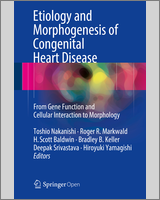Congenital heart disease (CHD) occurs in nearly 1 % of all live births and is the major cause of infant mortality and morbidity; about three per 1,000 live births will require some intervention during the first year of life. Additionally, 95 % of CHD patients survive to adulthood in these days, resulting in a growing population of adult CHD. Despite their clinical importance, the underlying genetic etiology of most CHD remains unknown, so-called “multifactorial” disease.
Identifying genetic cause of CHD is important not only to well understand the disease but also to enhance current knowledge about the molecular biology and genetics involved in the human cardiovascular development. Such knowledge may lead to new preventive and/or therapeutic strategies. Identification of disease genes would benefit the genetic counseling for CHD that is particularly important for the growing population of adult CHD. Deeper understanding of factors and pathways involved in differentiation of the cardiac stem cell and morphogenesis of the cardiovascular system would also provide the development of regenerative therapy for CHD.
During the last two decades, linkage analysis has been used to successfully identify disease genes involved in isolated CHD or genetic syndromes where CHD is part of the phenotype. However, this traditional approach is not generally suitable for CHD because it requires many large families with multiple affected individuals. During the same period, some of syndromes with chromosomal abnormalities have been well studied to identify disease genes in syndromic CHD. CHD is commonly a characteristic part of the clinical spectrum in a significant number of syndromes caused by chromosomal abnormalities, including submicroscopic deletions or duplications. To date, these genetic approaches have led to the identification of more than 50 human genes although they have limitation where large familial cases and chromosomal abnormalities account for relatively small portion of CHD.
Recently, a technique of genome-wide association studies (GWAS) has provided common genetic variations that can influence population-attributable risks of certain types of CHD although the information cannot be directly related to the affected individual. Finally, application of the next-generation sequencing (NGS) technologies is revolutionary in the field of genetics in CHD. In contrast to GWAS, the results of NGS are directly applicable to the affected individual. NGS can be targeted or nontargeted. Exome sequencing and whole-genome sequencing, scanning the whole exome of ~20,000 base pairs and the whole genome of ~3,000,000,000 base pairs, respectively, are well suited to the study of complex, heterogeneous diseases such as CHD and the current best technique for discovery of novel genetic causes for CHD. The biggest obstacle during any NGS analysis is, however, to single out the causal variant from the thousands of variants identified during sequencing. Follow-up animal studies, particularly in mice, for candidate genes discovered by genetic analyses have been successful in validating the candidates and uncovering the function of their gene products for the cardiovascular development. More recently, fine mapping of genomic copy number variants (CNVs) by NGS in patients with isolated or syndromic CHD has been used to identify candidate disease genes.
In this part, authors describe the current advance in genetics in CHD using linkage analysis, chromosomal studies, and CNVs studies by NGS, combined with animal experiments that verified novel genetic causes of CHD and provided new insights into the molecular and functional analyses of the cardiovascular development. Current understandings about molecular pathways associated with CHD involve numerous transcription factors and cofactors, including chromatin modifiers, and signaling molecules from ligands to receptors.

